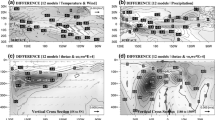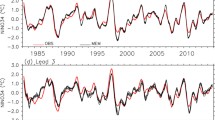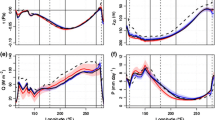Abstract
Characteristics of El Niño-Southern Oscillation (ENSO) have changed since the late 1970s as it synchronized with the Pacific Decadal Oscillation (PDO). In order to investigate the primary feedback process responsible for the interdecadal change in ENSO characteristics according to the PDO, using the ocean assimilation data (SODA) and the reanalysis data (NCEP/NCAR), we performed Bjerknes linear stability index (BJ index) analysis of two decadal periods: one before the late 1970s (the nPDO period) and the other after the late 1970s (the pPDO period). The BJ index for the pPDO period (−0.07 year−1 for the growth rate of the eastern Pacific SST anomaly) is significantly larger than that for the nPDO period (−0.25 year−1). The larger BJ index value is primarily due to the enhanced zonal advection feedback (ZA; +0.44 year−1), thermocline feedback (TH; +0.33 year−1), and the reduced damping by the mean meridional current (MD; +0.16 year−1). The increases in ZA and TH are mainly attributed to the shoaling of the mean thermocline depth, which increased the sensitivity of the ocean dynamic fields to the wind forcing; and the reduced MD is related to the reduced mean meridional current associated with the weakened trade wind. The enhanced positive feedback is partly compensated by the enhanced thermodynamic damping including the shortwave, sensible heat flux and latent heat flux (collectively, −0.88 year−1). Interestingly, the change in air–sea coupling strength from the nPDO to the pPDO period was small. Without the two extreme El Niño events (1982–1983 and 1997–1998) in the pPDO period (pPDO_noBIG), the difference in BJ index between nPDO and pPDO_noBIG periods became smaller (~0.07 year−1), indicating that the two extreme El Niño events largely contribute to the larger ENSO variability of the pPDO period, possibly due to nonlinear feedback processes. Nevertheless, qualitative similarity in each of the feedback and damping components of BJ index exists between the pPDO and pPDO_noBIG periods, which suggests that the tropical climate states of the pPDO period provided more favorable conditions for the emergence of extreme El Niño events by intensifying the linear feedback processes.





Similar content being viewed by others
References
An S-I (2009) A review of interdecadal changes in the nonlinearity of the El Nino-Southern Oscillation. Theor Appl Climatol 97:29–40
An S-I, Choi J (2015) Why the twenty-first century tropical Pacific trend pattern cannot significantly influence ENSO amplitude? Clim Dyn 44:133–146
An S-I, Jin F-F (2000) An eigen analysis of the interdecadal changes in the structure and frequency of ENSO mode. Geophys Res Lett 27:2573–2576
An S-I, Jin F-F (2004) Nonlinearity and asymmetry of ENSO. J Clim 17:2399–2412
An S-I, Kang I-S (2000) A further investigation of the recharge oscillator paradigm for ENSO using a simple coupled model with the zonal mean and eddy separated. J Clim 13:1987–1993
An S-I, Kang I-S (2001) Tropical Pacific basin-wide adjustment and oceanic waves. Geophys Res Lett 28:3975–3978
An S-I, Wang B (2000) Interdecadal change of the structure of the ENSO mode and its impact on the ENSO frequency. J Clim 13:2044–2055
An S-I, Jin F-F, Kang I-S (1999) The role of zonal advection feedback in phase transition. J Meteorol Soc Jpn 77:1151–1160
An S-I, Hsieh WW, Jin F-F (2005) A nonlinear analysis of the ENSO cycle and its interdecadal changes. J Clim 18:3229–3239
An S-I, Ye Z, Hsieh WW (2006) Changes in the leading ENSO modes associated with the late 1970s climate shift: role of surface zonal current. Geophys Res Lett 33:L14609. doi:10.1029/2006GL026604
Bretherton CS, Smith C, Wallace JM (1992) An intercomparison of methods for finding coupled patterns in climate data. J Clim 5:541–560
Chen L, Li T, Yu Y (2015) Causes of strengthening and weakening of ENSO amplitude under global warming in four CMIP5 models. J Clim 28:3250–3274
Choi J, An S-I, Yeh S-W (2012) Decadal amplitude modulation of two types of ENSO and its relationship with the mean state. Clim Dyn 38:2631–2644
Choi J, An S-I, Yeh S-W, Yu J-Y (2013) ENSO-like and ENSO-induced tropical Pacific decadal variability in CGCMs. J Clim 26:1485–1501
Dewitte B, Yeh S-W, Thual S (2013) Reinterpreting the thermocline feedback in the western-central equatorial Pacific and its relationship with the ENSO modulation. Clim Dyn 41:819–830
Fedorov AV, Philander SG (2000) Is El Niño changing? Science 288:1997–2002
Fedorov AV, Philander SG (2001) A stability analysis of tropical ocean-atmosphere interactions: bridging measurements and theory for El Nino. J Clim 14:3086–3101
Graham FS, Brown JN, Langlais C, Marsland SJ, Wittenberg AT, Holbrook NJ (2014) Effectiveness of the Bjerknes stability index in representing ocean dynamics. Clim Dyn 43:2399–2414
Hirst AC (1986) Unstable and damped equatorial modes in simple coupled ocean-atmosphere models. J Atmos Sci 43:606–632
Hong LC, Linho Jin FF (2014) A southern hemisphere booster of super El Niño. Geophys Res Lett 41:2142–2149. doi:10.1002/2014GL059370
Im S-H, An S-I, Kim ST, Jin F-F (2015) Feedback processes responsible for El Nino–La Nina amplitude asymmetry. Geophys Res Lett 42:5556–5563
Jin F-F (1997) An equatorial ocean recharge paradigm for ENSO. Part 1: conceptual model. J Atmos Sci 54:811–829
Jin F-F, Neelin JD (1993) Modes of interannual tropical ocean-atmosphere interaction—a unified view. Part I: numerical resutls. J Atmos Sci 50:3477–3502
Jin F-F, Neelin JD, Ghil M (1996) El Nino/Southern Oscillation and the annual cycle: subharmonic frequency-locking and aperiodicity. Phys D 98:442–465
Jin F-F, Kim ST, Bejarano L (2006) A coupled-stability index for ENSO. Geophys Res Lett 33:L23708. doi:10.1029/2006GL027221
Jin F-F, Lin L, Timmermann A, Zhao J (2007) Ensemble-mean dynamics of the ENSO recharge oscillator under state-dependent stochastic forcing. Geophys Res Lett 34:L03807. doi:10.1029/2006GL027372
Kalnay E, Kanamitsu M, Kistler R, Collins W, Deaven D, Gandin L, Iredell M, Saha S, White G, Woollen J (1996) The NCEP/NCAR 40-year reanalysis project. Bull Am Meteorol Soc 77:437–471
Kim ST, Jin F-F (2011) An ENSO stability analysis. Part I: results from a hybrid coupled model. Clim Dyn 36:1593–1607
Kim ST, Cai W, Jin F-F, Santoso A, Wu L, Guilyardi E, An S-I (2014) Response of El Nino sea surface temperature variability to greenhouse warming. Nat Clim Change 4:786–790
Kistler R, Collins W, Saha S, White G, Woollen J, Kalnay E, Chelliah M, Ebisuzaki W, Kanamitsu M, Kousky V (2001) The NCEP-NCAR 50-year reanalysis: monthly means CD-ROM and documentation. Bull Am Meteorol Soc 82:247–267
Kug J-S, Kang I-S, An S-I (2003) Symmetric and antisymmetric mass exchanges between the equatorial and off-equatorial Pacific associated with ENSO. J Geophys Res 108(C8):3284. doi:10.1029/2002JC001671
Kug J-S, Jin F-F, Sooraj K, Kang I-S (2008) State-dependent atmospheric noise associated with ENSO. Geophys Res Lett 35:L05701. doi:10.1029/2007GL032017
Liu Z, Lu Z, Wen X, Otto-Bliesner B, Timmermann A, Cobb K (2014) Evolution and forcing mechanisms of El Nino over the past 21,000 years. Nature 515:550–553
Lloyd J, Guilyardi E, Weller H, Slingo J (2009) The role of atmosphere feedbacks during ENSO in the CMIP3 models. Atmos Sci Lett 10:170–176
Lloyd J, Guilyardi E, Weller H (2011) The role of atmosphere feedbacks during ENSO in the CMIP3 models. Part II: using AMIP runs to understand the heat flux feedback mechanisms. Clim Dyn 37:1271–1292
Lloyd J, Guilyardi E, Weller H (2012) The role of atmosphere feedbacks during ENSO in the CMIP3 models. Part III: the shortwave flux feedback. J Clim 25:4275–4293
Lubbeck JF, McPhaen MJ (2014) Assessing the twenty-first-century shift in ENSO variability in terms of the Bjerknes stability index. J Clim 27:2577–2587
Mantua NJ, Hare SR, Zhang Y, Wallace JM, Francis RC (1997) A Pacific interdecadal climate oscillation with impacts on salmon production. Bull Am Meteorol Soc 78:1069–1079
Miller AJ, Cayan DR, Barnett TP, Graham NE, Oberhuber JM (1994) The 1976–77 climate shift of the Pacific Ocean. Oceanography 7:21–26
Penland C, Sardeshmukh PD (1995) The optimal growth of tropical sea surface temperature anomalies. J Clim 8:1999–2024
Santoso A, Mcgregor S, Jin F-F, Cai W, England MH, An S-I, Mcphaden MJ, Guilyardi E (2013) Late-twentieth-century emergence of the El Niño propagation asymmetry and future projections. Nature 504:126–130
Thompson C, Battisti D (2000) A linear stochastic dynamical model of ENSO. Part I: model development. J Clim 13:2818–2832
Thompson C, Battisti D (2001) A linear stochastic dynamical model of ENSO. Part II: analysis. J Clim 14:445–466
Thual S, Dewitte B, An S-I, Illig S, Ayoub N (2013) Influence of recent stratification changes on ENSO stability in a conceptual model of the equatorial Pacific. J Clim 26:4790–4802
Wakata Y, Sarachik E (1991) On the role of equatorial ocean modes in the ENSO cycle. J Phys Oceanogr 21:434–443
Waliser DE, Blanke B, Neelin JD, Gautier C (1994) Shortwave feedbacks and El Niño-Southern Oscillation: forced ocean and coupled ocean-atmosphere experiments. J Geophys Res 99:25109–25125
Wang B, An S-I (2001) Why the properties of El Niño changed during the late 1970s. Geophys Res Lett 28:3709–3712
Wang B, An S-I (2002) A mechanism for decadal changes of ENSO behavior: roles of background wind changes. Clim Dyn 18:475–486
Wittenberg AT (2009) Are historical records sufficient to constrain ENSO simulations? Geophys Res Lett 36:L12702. doi:10.1029/2009GL038710
Zebiak SE, Cane MA (1987) A model EI Nino-Southern Oscillation. Mon Weather Rev 115:2262–2278
Acknowledgments
This research was supported by the Basic Science Research Program through the National Research Foundation of Korea (NRF) funded by the Ministry of Science, ICT and Future Planning (No. 2014R1A2A1A11049497).
Author information
Authors and Affiliations
Corresponding author
Appendices
Appendix 1: Parameters of the BJ index
\(L_{x}\) and \(L_{y}\) in the first two terms of Eq. (2) are the zonal and meridional distances in the eastern box; a1 and a2 are estimated to reform the zonal and meridional mixed layer advections in partial flux form, i.e., \(- \frac{{\partial (\bar{u}T)}}{{\partial {\text{x}}}} - \frac{{\partial (\bar{v}T)}}{{\partial {\text{y}}}},\) respectively, where \(\bar{u}\) and \(\bar{v}\) represent climatologically averaged mixed layer currents.
The net downward heat flux change in SST anomaly can be written in the following form:
where \(\alpha_{s}\) is the thermodynamic damping regression coefficient.
The ocean-to-atmosphere impact is presented by a simple linear relationship between SST and wind stress. The equatorial basin-wide (120°E–80°W) trade wind anomaly can be simply described in linear form using the least-square estimation with respect to the SST anomaly over the eastern box:
where \(\mu_{a}\) is wind response to SST forcing.
In the zonal advection feedback term, \(- \left\langle \frac{{\partial \bar{T}}}{\partial x} \right\rangle_{E}\) is the zonal temperature gradient of the mean mixed layer temperature, and the zonal mixed-layer current is determined by surface wind stress (i.e., Ekman current) and thermocline depth field (i.e., geostrophic current) as follows:
where \(\left\langle h\right\rangle_{w}\) is an ocean heat content averaged over the western box (vertically integrated ocean temperature from the surface to 300 m depth). The two coefficients \(\beta_{u}\) (wind response to SST forcing) and \(\beta_{uh}\) (geostrophic current adjusted to thermocline depth) determine the zonal current so that, unlike other equations, the coefficients are estimated using a multiple linear regression.
In the thermocline feedback, \(\beta_{h}\) represents the sensitivity of a zonal contrast of heat content between the two boxes to wind stress forcing as follows:
\(\alpha_{h}\) represents an effect of thermocline depth changes on ocean subsurface temperatures, \(H\left( {\bar{w}} \right)\) is a step function to consider only climatological upwelling from below the subsurface region to the mixed layer as follows:
In Ekman (upwelling) feedback, \(-\left\langle \frac{{\partial \bar{T}}}{\partial z}\right\rangle_{E}\) is the mean vertical temperature gradient within the mixed layer, and the vertical motion forced by the wind stress can be presented in the following form:
where \(\beta_{w}\) is a response of ocean upwelling to wind forcing.
Appendix 2: β h and β uh modified by the wind stress pattern
The oceanic Rossby waves are generated by wind stress curl, which is modified by the meridional width of the wind stress. In order to explore the oceanic wave generation against the wind stress pattern, we computed the wind stress curl generated by the simplified wind stress pattern. Suppose a zonal wind stress resembling the zonal wind stress pattern during El Niño is as follows:
where y is the latitude, \(\tau_{M} (y_{0} )\) is the maximum zonal wind stress amplitude at \(y_{0} ,\,L_{y}\) is the e-folding scale. Suppose \(y_{0} = 0,\) then, wind stress curl (assuming \(\tau_{y} = 0\)) becomes
Therefore, larger L y results in smaller wind stress curl. We then computed the latitude of maximum wind stress curl by taking a partial derivative of (10) as follows:
and the maximum latitude of the wind stress curl is \({\text{y}}_{max} = \pm \frac{{L_{y} }}{\sqrt 2 }.\) Therefore, as L y increases, i.e., increased meridional width of zonal wind stress, the latitude of maximum wind stress curl increases.
Appendix 3: β h , β u , and β w modified by ocean structure
As in Sect. 3.2:
and
where \(g^{{\prime }}\) is reduced gravity; \(\rho\) is sea water density; \({\text{L}}\) is Pacific basin length; H, H1, and H2 (H = H1 + H2) are upper layer depth, mixed layer depth, and lower layer depth, respectively. All three are inversely proportional to H.
H slowly changes in time as follows:
where \(H_{0}\) is a constant, and \(\tilde{H}(t)\) is a slowly varying mean thermocline depth. Since \(\tilde{H}(t) \ll H_{0} ,\) the slowly varying \(\beta_{i}\) (i = u, h, w), \(\tilde{\beta }_{i}\) becomes
Therefore, the deepening of the mean thermocline results in the reduction of sensitivity of \(\beta\) to wind forcing, which is opposite for the shoaling of the mean thermocline.
The reduced gravity \(g^{{\prime }} = g\frac{{\rho_{2} - \rho_{1} }}{\rho },\) where \(\rho_{1}\) and \(\rho_{2}\) are the density above and below the thermocline, respectively. Therefore, the warming of the water above the thermocline reduces the density, \(\rho_{1} ,\) and thus increases \(g^{{\prime }} ,\) which results in decreased \(\beta_{h}\).
Appendix 4
A linearized SST equation can be written as
Where a bar and a prime indicate the time mean and the perturbation from the time mean, respectively. Usually in a linearization, the time mean quantity has a unit dimension, while the prime has the dimension of an epsilon (ε ≪ 1). Therefore, a linear term in (17) (scale = ε) is greater than a nonlinear term (scale = ε2). However, as a system is growing, the perturbation could reaches larger than a unit through a linear feedback, and then the nonlinear term can strongly booster the perturbation to be a big event because the nonlinear term (scale = Ε2) becomes greater than the linear term (scale = Ε, where Ε > 1). Note that this explanation is only valid for a quadratic nonlinearity.
Rights and permissions
About this article
Cite this article
An, SI., Bong, H. Inter-decadal change in El Niño-Southern Oscillation examined with Bjerknes stability index analysis. Clim Dyn 47, 967–979 (2016). https://doi.org/10.1007/s00382-015-2883-8
Received:
Accepted:
Published:
Issue Date:
DOI: https://doi.org/10.1007/s00382-015-2883-8




